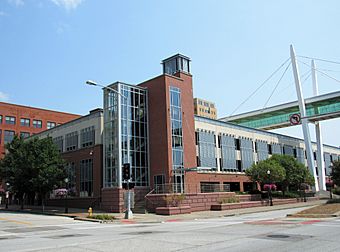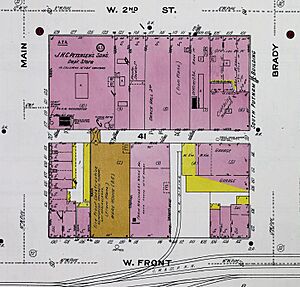Schauder Hotel facts for kids
|
Schauder Hotel
|
|
|
Formerly listed on the U.S. National Register of Historic Places
|
|

The building was located where this parking ramp now stands.
|
|
| Location | 126 W. River Dr. Davenport, Iowa |
|---|---|
| Area | less than one acre |
| Built | 1876 |
| Architectural style | Italianate |
| MPS | Davenport MRA |
| NRHP reference No. | 83002495 |
Quick facts for kids Significant dates |
|
| Added to NRHP | July 7, 1983 |
| Removed from NRHP | December 19, 2014 |
The Schauder Hotel was an old building in downtown Davenport, Iowa. It was built in 1876 in the Italianate style. This means it had a classic look with tall windows and fancy decorations. The hotel faced the Mississippi River. It was added to the National Register of Historic Places in 1983 because of its history.
History of the Schauder Hotel
Louis Schauder built the hotel in 1876. At that time, there were five hotels close by on West Front Street. This street is now called West River Drive. Mr. Schauder also ran another hotel nearby, called the Perry Hotel.
By the 1880s, the Schauder Hotel had a saloon and a music hall. These were places where people could relax and enjoy themselves. The hotel stayed open until the early 1900s. Later, a large department store, Petersen, Harned, and Von Maur, bought the building. They used it for storage.
In 2014, the Schauder Hotel was taken off the National Register of Historic Places. This happened because the building was torn down. It was removed along with other nearby buildings. These included the Clifton-Metropolitan Hotel, the J.H.C. Petersen's Sons Wholesale Building, and the Schick's Express and Transfer Co.. They were all taken down to build a public parking garage and the Davenport Skybridge.
What the Hotel Looked Like
The Schauder Hotel was a three-story building. It had a special design called Italianate style. The front of the building, called the facade, had four sections of windows above the first floor.
The windows on the second and third floors were tall and narrow. They had decorative hoods above them. These fancy window hoods were a key part of the Italianate style. The ground floor of the building was changed over the years. Also, the original decorative trim at the top, called the cornice, was either partly removed or replaced.




